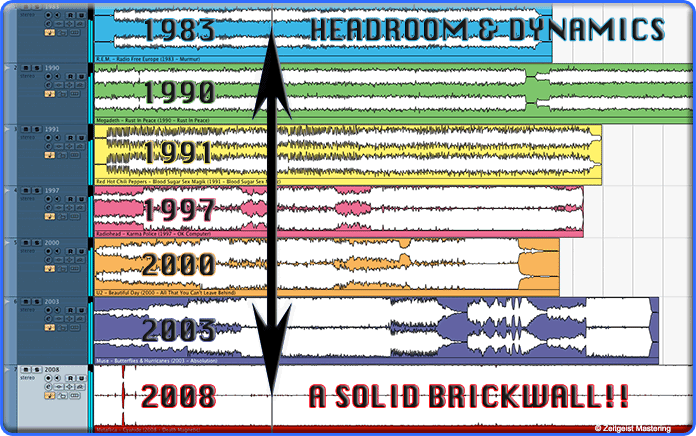“The Loudness Wars” is a phrase coined in the 1990s to describe the growing demand by labels for increasingly louder mastering. As the Compact Disc format gained prominence, engineers began pushing the limits of it’s upper dynamic range, squeezing every last bit out of it before hitting digital zero (and thus distorting). A loud master translated to a louder sounding song on the radio compared to the competition. And since our ears perceive louder as better (in general), the louder sounding your song was, the more people would buy it, right?
The problem with this concept is that as soon as one label did it, all the labels began doing it, trying to outdo each other and things quickly got out of hand. Wikipedia has a wonderful article on The Loudness Wars complete with the following graphic example:

Different releases of Michael Jackson’s song “Black or White” show increasing loudness over time: 1991–1995–2008.
Thankfully after the 2008 fiasco involving Metallica’s Death Magnetic album, where the mastering was so loud as to actually digitally clip in most CD players, mastering engineers began fighting back. But considering the massive amounts of dynamic range available in modern digital systems, engineers still seem afraid of allowing music to breathe. Recording at 24bit yields a theoretical dynamic range of 144db, more than enough for any real-world application. An orchestra has a dynamic range of 70db, which is an incredible swing. I’m not advocating that kind of variation in other forms of music, but I’d wager that most pop right now has less than 3db of range across the entire album.

I bet this sounds great! A screen capture from an album by a band named Hypocrisy, courtesy of tvtropes.com
Overall, it seems the most extreme examples of the Loudness War are in the past. That said, there are still records being released that seem afraid of the possibility that a listener out there might have to actually adjust his/her volume now and again. Why is this?
Why is modern music production so scared of dynamics? I was listening to a new release on k-scope via progstreaming.com and while the music was very interesting, blending electronica and progressive music in a novel way, the lack of dynamics ruined the experience for me. Progressive music should have a lot of dynamics! That’s one of the things that makes such music interesting beyond the odd time signatures and long song forms.
The beginning of one song was especially egregious; it was obviously intended as a quieter part in the music, consisting of a lovely high falsetto lead vocal, piano, some atmospherics, and a bit of processed electronic drums. That all sounded great. Then the full band came in, acoustic drums channeling Bonzo, on a section that is (again obviously) supposed to be very powerful and the overall volume didn’t change at all! It stayed the same volume, sounding weak and neutered.
We have more clean dynamic range than ever before. Even the best analog master tape only had a 14bit depth (in digital terms) and at best 80db of useable dynamic range and yet those old Yes, Genesis, and ELP albums have far more contrast between the soft and loud passages than their modern counterparts.

Courtesy of zeitgestmastering.com
Let’s not be afraid of dynamics. There’s nothing more powerful and simple than a rousing crescendo or a gentle decrescendo. Music without dynamics is like painting without texture. Or food that is decadently over sweetened. Sure, it tastes good for a little while but you quickly become fatigued and long for something with substance.

Perhaps they should take note of the preschool teachers who tell us that the best way to get a child’s attention is to speak quietly?